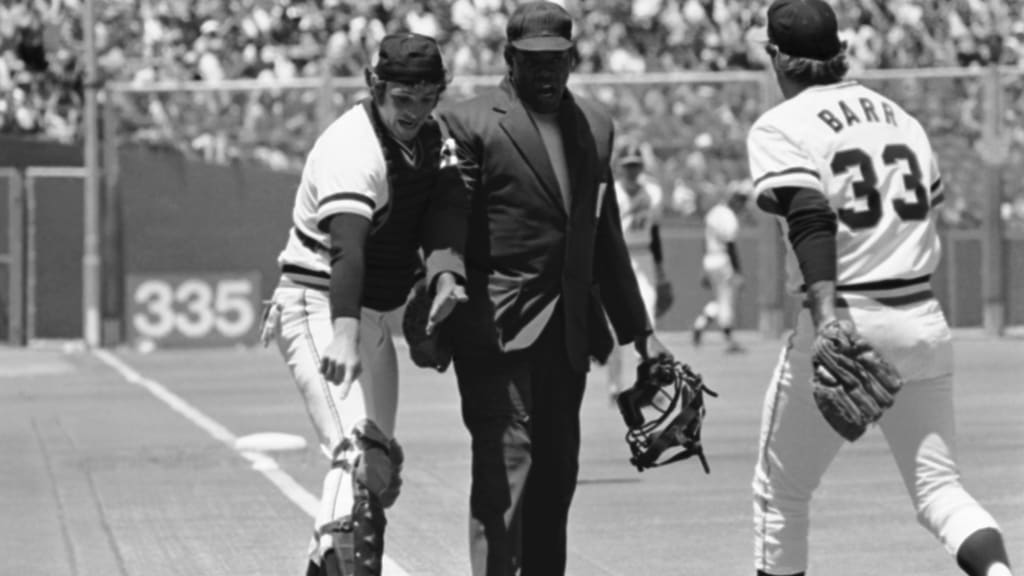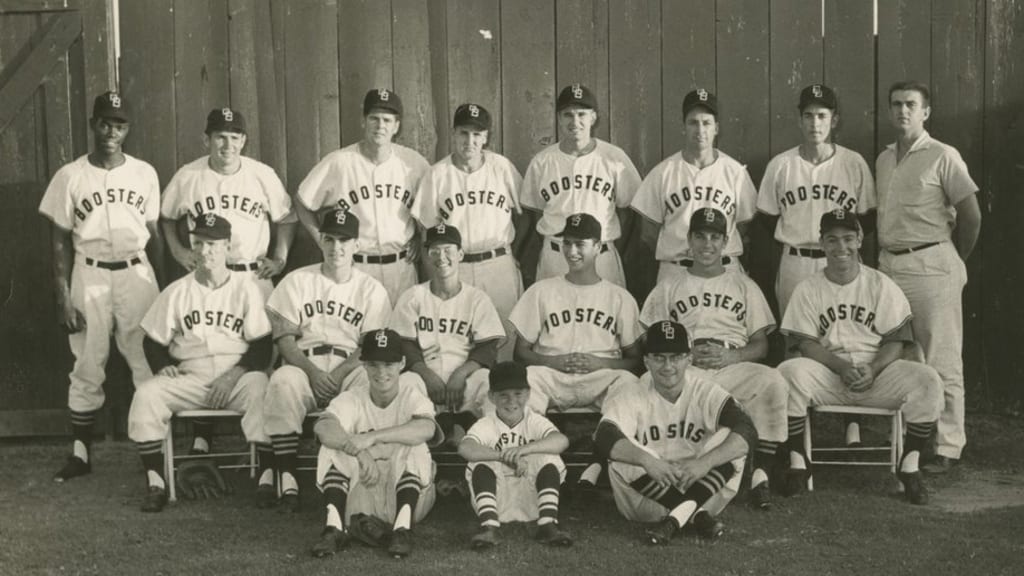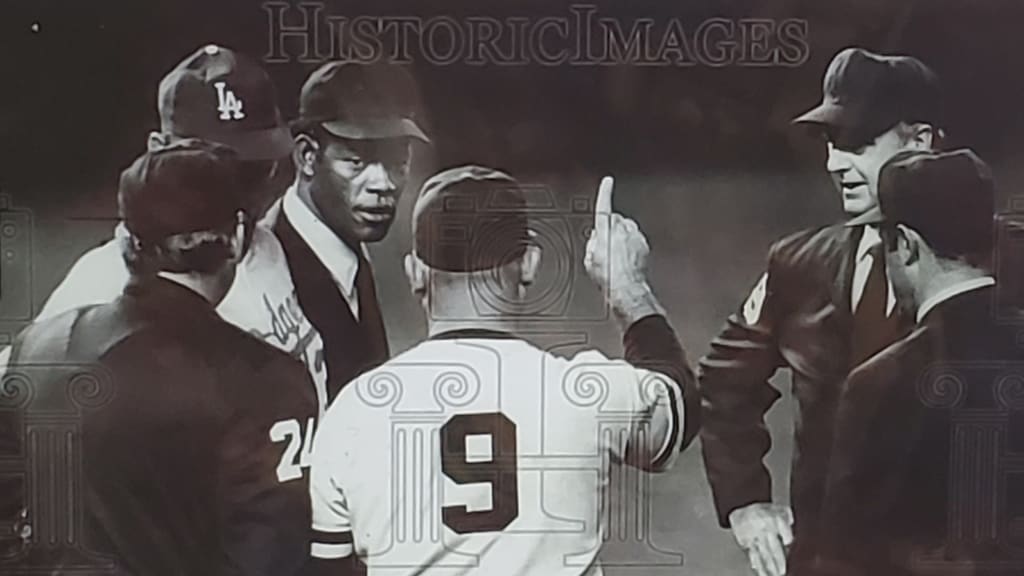
On a Monday night midway through the final month of the 1972 season, there were only four Major League Baseball games on the docket -- a third of what was commonly the case, especially with the September stretch run in full effect. Three of those games took place in the Eastern United States: New York, Boston and Cincinnati.
The most monumental contest was occurring more than 2,000 miles away. At 7:30 p.m. Pacific Time, a reported crowd of 2,556 fans gathered to watch a matchup between the Los Angeles Dodgers and San Diego Padres -- the latter of whom had joined MLB alongside the Montreal Expos through expansion in 1969 -- at San Diego Stadium, where history was about to take place.
Shortly before first pitch, as the umpiring crew emerged from the tunnel and took the field, the stadium scoreboard lit up with a message: “Welcome Art Williams, the National League’s First Black Umpire.”
The crowd took to its feet and gave a standing ovation. Dr. Audie Williams, Art’s youngest brother and the only one of his six siblings still alive today, remembers it like it was yesterday. Now 81, Audie had been standing on that field alongside Art not long before, taking in the scene pregame after spending time in the umpires’ room.
“Art just grabbed me and hugged me. I’ll never forget what he said to me: ‘This is unbelievable,’” Audie recalled in a recent phone interview. “The other umpires said, ‘Art, you’ve got to come on, we got to go to work, man.’
“I stood there, and I watched him warm up on the field, and I knew he was making history. And he knew he was making history.”
And so it was that on Sept. 18, 1972, Art Williams made his Major League debut as the third-base ump at the age of 38, becoming the first Black umpire in National League history and the second in AL/NL history. Emmett Ashford was the first, having made his debut on Opening Day six years earlier; coincidentally enough, he was also at third base when he broke the umpiring color line on April 11, 1966.
A quarter-century after Jackie Robinson became the first Black player in modern NL history with the Brooklyn Dodgers and Larry Doby followed suit as the first Black player in the American League with the Cleveland Indians in 1947, both leagues were integrated for umpires, too.
Williams’ family -- his wife, Shirley, and five children among them -- had driven down to San Diego from their hometown of Bakersfield, Calif., to witness the barrier-breaking occasion. A full-time ump in the Triple-A International League, Williams had been called up to the big leagues for a trial run in the final days of the 1972 season.
“We were just over the moon watching him go out there and perform,” Audie said. “It was unbelievable.”
Also in attendance at the ballpark that night was Ashford himself. After five years umpiring at the game’s highest level, capped off by an assignment working the 1970 World Series, Ashford had retired and taken on a job as a public relations advisor for MLB Commissioner Bowie Kuhn. He had been watching Williams for a few years while the latter was quickly rising up the ranks in the Minors. After the game, the whole family went out to dinner with Ashford at the hotel where they were staying.
“Theirs seemed to be a warm relationship,” Audie said of the two pioneers. “I was just watching when they were talking, and they were cordial with each other. Emmett was very respectful and very supportive of Art. That’s the impression I got.”
There was one more trailblazer in the building that night. Suited up for the Dodgers in left field, stationed just a few short yards away from Williams, was Hall of Famer Frank Robinson. The only person to win the Most Valuable Player Award in both the AL and NL, Robinson became the first Black manager in AL/NL history in 1975, when Cleveland named him as its player-manager.
For Williams, his Majors debut came just four years after he was first hired as a Minor League umpire, a notably short amount of time compared to the 7-10 years usually seen within the profession; even Ashford spent 15 years in the game’s lower levels before receiving his big break.
“There are a lot of umpires in the Minor Leagues, and right up here in the Majors, who are jealous of me because I’m Black and have gotten a few breaks because of it,” Williams told Sports Illustrated in June 1975, a few months before his highest-profile gig working the NL Championship Series. “But they don’t know, don’t realize, that I’ve also lost out on many opportunities earlier in life for the same Blackness. They don’t understand, furthermore, that I can’t help my color one way or another. I am what I am.”
Williams had been working in the Bakersfield sanitation department to support his young family, spending his spare time umpiring Little League, high school and college baseball games. Still, he had become one of the more sought-after umps in the area, according to his younger brother, so much so that a scout from the San Francisco Giants suggested that he could make it as a pro. That left an imprint on Williams, who had once wanted to reach the Majors as a player.

Born in Camden, Ark., on Feb. 24, 1934, Williams was raised in a family of sharecroppers. Growing up in the South during the Jim Crow era, he was exposed to injustice on a regular basis. On one occasion, as Audie recalled, when it was time for the family to be paid by the landlord for their work, the money came out much shorter than expected. But there was no legal recourse for them to take.
“My dad really got tired of sharecropping. He wanted to do something else,” Audie said. “He started hearing about opportunities for Black people out in California. Matter of fact, Blacks back then from Arkansas referred to California as a promised land. ... [So] we went to Bakersfield to try to provide a better life for us.”
During his time at Bakersfield High School, Williams was a star right-hander, pitching his team to a league championship in 1953. That generated a lot of attention in the region, and shortly after graduation, a scout from the Detroit Tigers came over to his house, offering a professional contract. With that, Williams became the first Black player signed by the Tigers’ organization.
He found success in his first two seasons with the Tigers’ California League and Pioneer League affiliates in Bakersfield and Idaho, respectively, going 11-6 with a 3.26 ERA in 20 starts in 1953 and then 9-3 with a 4.81 ERA in 25 appearances in ’54. But Williams’ career took a downturn after that due to mismanagement of his throwing arm. He logged a whopping 242 innings in the ’56 season alone and sustained an elbow injury that put an abrupt end to his pitching aspirations.
That’s when Williams’ high school baseball coach, Carl Berra, stepped in and put him on the path to umpiring instead. While on the local circuit, he met future Major League umpire Bob Engel, a Bakersfield native, who was then umpiring in the California League. Engel convinced Williams to attend an umpire development school in Florida, but Williams then had to convince Shirley that it was a good idea for their growing family.
“That was Art’s dream, and that’s what he wanted to do,” Audie said. “He asked his wife to support him in that endeavor for five years, and if he didn’t make it in five years, he would get a real job. So God bless him, he made it in four and a half years.”
After enrolling in the ump school in 1969, Williams was hired in the Rookie-level Pioneer League. He moved up to the Midwest League the next year, the Texas League the year after that and the International League the year after that. Mere months later, he got the call to the big leagues from Fred Fleig, the NL’s umpire supervisor, and made his momentous MLB debut.
As told to The Sporting News in May 1973, there had been other Black umpires trying to follow in Ashford’s footsteps, but Warren Giles, the NL’s president from 1951-69, said: “Williams is the first one [scouts and league officials] thought could do the job.”
Williams was hired as a full-time ump ahead of the 1973 MLB season, and he spent five years in the position before being dismissed after the ’77 season, nominally for incompetence. Williams, the league’s only Black ump throughout his tenure, alleged racial motivations for that decision -- citing the impending promotion of another Black umpire, Eric Gregg, as evidence of a quota -- and filed a complaint with the Equal Opportunity Employment Commission.
When asked for his thoughts, Ashford admitted to the New York Daily News in May 1978 that Williams’ ratings were down compared to his fellow umps, but he also noted that Williams might have been rushed into such a prominent role.
“I think Art came up too quick,” Ashford said. “There are so many things you have to learn. You have to make your mistakes in the Minor Leagues, not the Majors.”
Williams passed away the following year at the age of 44. A tumor was found in his brain and the subsequent surgery left him in a coma for six weeks until his death on Feb. 8, 1979. Ashford, Engel and Berra were among the members of his baseball family who paid their respects by delivering eulogies at his funeral service, which was attended by more than 1,000 people at St. John’s Baptist Church in southeast Bakersfield.

In the many years since, Audie, who earned his doctorate in education from the University of California-Santa Barbara, has been trying to figure out how to keep the memory of his brother’s historic accomplishment alive. In the late 1990s, he set out to author a book, but the emotional toll of the writing process hindered its completion. That is, until 2021, when KGET 17 (Bakersfield’s local television station) reached out to him with a desire to produce a Black History Month segment on Williams. The segment garnered an Emmy and the attention of an Atlanta-based documentary filmmaker, who then made a half-hour short that has claimed top prizes at several film festivals since its release in ’22.
Those experiences compelled Audie to finish the biography, which he did just in time for the 50th anniversary of Williams’ MLB debut; “Unbelievable! The Life Journey of Art Williams: Baseball’s First Black National League Umpire” was released last May. And in a culmination of that push to commemorate Williams’ legacy, Bakersfield Mayor Karen Goh proclaimed that Sept. 18, 2022, would be recognized by the city as “Art Williams Day.”
“My dad, even when we were younger, talked about his brother so much. It kind of spurs all of us to do better or to be really good role models and set examples,” said Dr. Maria Williams-Slaughter, Art’s niece, via phone. “It’s history, and we just want to make sure that it stays out there for people to point to or to aspire to, to be involved in baseball or involved in anything. But just to do it and to give 110 percent.”
Though there have only been 10 Black umpires in AL/NL history, there will be five among the 76 full-time umps during the 2023 MLB season: Adrian Johnson and Alan Porter -- who were recently named the second and third Black crew chiefs -- Jeremie Rehak, C.B. Bucknor and new hire Malachi Moore.
As baseball history continues to be made, Audie has hope that the story of Art Williams will remain part of the cultural conversation, even when he’s no longer the one telling it.
